Forecasting Canadian Age-Specific Mortality Rates: Application of Functional Time Series Analysis
Abstract
:1. Introduction
2. Materials and Methods
2.1. Canadian Age-Specific Mortality Rates
2.2. Smoothing Techniques
2.3. Functional Principal Component Regression (FPCR)
2.4. A Univariate Time Series Forecasting Method
2.5. Functional Autoregressive Process (FAR) of Order One
2.6. Prediction Interval and Forecast Accuracy
2.7. Evaluation of Interval Forecast Accuracy
3. Results
3.1. Temporal Patterns of Mortality Rates
3.2. Age-Specific Mortality Forecasting for Canada
3.3. Age Difference in Forecasted Mortality Rate Using FAR(1)
4. Discussion
Supplementary Materials
Author Contributions
Funding
Data Availability Statement
Acknowledgments
Conflicts of Interest
References
- Canadian Human Mortality Database 2014. Universite de Montreal (Canada), University of Californica Berkley (USA), and Max Planck Institute for Demographic Research (Germany). Available online: http://www.bdlc.umontreal.ca (accessed on 2 June 2022).
- Statistics Canada. Data Table 13-10-0710-01. Available online: https://www150.statcan.gc.ca/t1/tbl1/en/tv.action?pid=1310071001 (accessed on 29 August 2022).
- Bourheau, R.; Ouellette, N. Trends, patterns, and differentials in Canadian mortality over nearly a century (1921–2011). Canaidan Stud. Popul. 2016, 43, 48–77. [Google Scholar] [CrossRef]
- Bah, S.M.; Rajulton, F. Has Canadian mortality entered the fourth stage of the epidemiologic transition. Can. Stud. Popul. 1991, 18, 18–41. [Google Scholar] [CrossRef]
- Bourbearu, R. Canadian mortality in perspective: A comparison with the United States and other developed courntries. Can. Stud. Popul. 2002, 29, 313–369. [Google Scholar] [CrossRef]
- Lussier, M.-H.; Bourbeaue, R.; Choiniere, R. Does the recent evolution of Candian mortality agree with the epidemiological transition theory? Demogr. Res. 2008, 18, 531–568. [Google Scholar] [CrossRef]
- Mandich, S.; Margolis, R. Changes in disability-free life expectancy in Canada between 1994 and 2007. Can. Stud. Popul. 2014, 41, 192–208. [Google Scholar]
- Jasilionis, D. Reversals in life expectancy in high income countries? BMJ 2018, 362, k3399. [Google Scholar] [CrossRef]
- Hyndman, R.J.; Ullah, S. Robust forecasting of mortality and fertility rates: A Functional data approach. Comput. Stat. Data Anal. 2007, 51, 4942–4956. [Google Scholar] [CrossRef]
- Lee, R.D.; Carter, L.R. Modeling and forecasting U.S. mortality. J. Am. Stat. Assoc. 1992, 87, 659–671. [Google Scholar] [CrossRef]
- Lee, R.D.; Miller, T. Evaluating the performance of Lee-Carter method for forecasting mortality. Demography 2001, 38, 537–549. [Google Scholar] [CrossRef]
- Booth, H.; Maindonald, J.; Smith, L. Applying Lee-Carter under conditions of variable mortality decline. Popul. Stud. 2002, 56, 325–336. [Google Scholar] [CrossRef]
- Renshaw, A.E.; Haberman, S. Lee-Carter mortality forecasting: A parallel generalized linear modeling appraoch for England and Wales mortality projections. Appl. Stat. 2003, 52, 119–137. [Google Scholar] [CrossRef]
- De Jong, P.; Tickle, L. Extending Lee-Carter mortality forecasting. Math. Popul. Stud. 2006, 13, 1–18. [Google Scholar] [CrossRef]
- Ramsay, J.O.; Silverman, B.W. Functional Data Analysis; Springer: New York, NY, USA, 2005. [Google Scholar]
- Aguilera, A.M.; Escabias, M.; Valdarrama, M.J. Using principal components for estimating logistic regression with high dimensitional multicolinear data. Comput. Stat. Data Anal. 2006, 50, 1905–1924. [Google Scholar] [CrossRef]
- Shang, H.L.; Hyndman, R.J. Grouped Functional Time Series Forecasting: An Application to Age-Specific Mortality Rates. J. Comput. Graph. Stat. 2017, 26, 330–343. [Google Scholar] [CrossRef]
- Wang, J.-L.; Chiou, J.-M.; Müller, H.-G. Functional Data Analysis. Annu. Rev. Stat. Its Appl. 2016, 3, 257–295. [Google Scholar] [CrossRef]
- Thakallapelli, A.; Ghosh, S.; Kamalasadan, S. Real-time Frequency Based Reduced Order Modeling of Large Power Grid. In Proceedings of the Power and Energy Society General Meeting, Boston, MA, USA, 17–21 July 2016. [Google Scholar]
- Pitor, K.; Matthew, R. Introduction to Functional Data Analysis, 1st ed.; CRC Press: Boca Raton, FL, USA; Taylor and Francis Group: New York, NY, USA, 2017. [Google Scholar]
- Hyndman, R.J.; Zeng, Y.; Shang, H.L. Forecasting the old-age dependency ratio to determine a sustainable pension age. Aust. N. Z. J. Stat. 2021, 63, 241–256. [Google Scholar] [CrossRef]
- Organization for Economic Co-Operation and Development (OECD). OECD Health Statistics 2014. Website: Public Expenditure on Health, % Total Expenditure on Health. Available online: http://stats.orecd.org/Index.aspx?DataSetCode=SHA (accessed on 1 August 2022).
- Hörmann, S.; Kokoszka, P. Weakly dependent functional data. Ann. Stat. 2010, 38, 1845–1884. [Google Scholar] [CrossRef]
- Wood, S.N. Stable and Efficient Multiple Smoothing Parameter Estimation for Generalized Additive Models. J. Am. Stat. Assoc. 2004, 99, 673–686. [Google Scholar] [CrossRef]
- Shang, H.L.; RobJ, H. Nonparametric time series forecasting with dynamic updating. Math. Comput. Simul. 2011, 81, 1310–1324. [Google Scholar] [CrossRef]
- Erbas, B.; Akram, M.; Gertig, D.M.; English, D.; Hopper, J.L.; Kavanagh, A.M.; Hyndman, R. Using Functional Data Analysis Models to Estimate Future Time Trends in Age-Specific Breast Cancer Mortality for the United States and England–Wales. J. Epidemiol. 2010, 20, 159–165. [Google Scholar] [CrossRef]
- Shen, H.; Huang, J.Z. Interday Forecasting and Intraday Updating of Call Center Arrivals. Manuf. Serv. Oper. Manag. 2008, 10, 391–410. [Google Scholar] [CrossRef]
- Hall, P.; Hosseini-Nasab, M. On properties of functional principal components analysis. J. R Stat. Soc. B 2006, 65, 109–126. [Google Scholar] [CrossRef]
- Hyndman, R.J.; Shang, H.L. Forecasting functional time series. J. Korean Stat. Soc. 2009, 38, 199–211. [Google Scholar] [CrossRef]
- Hyndman, R.J.; Khandakar, Y. Automatic Time Series Forecasting: The forecast Package for R. J. Stat. Softw. 2008, 27, 1–22. [Google Scholar] [CrossRef]
- Bosq, D. Implementation of Functional Autoregressive Predictors and Numerical Applications. In Linear Process Functioal Spaces; Springer: New York, NY, USA, 2000; pp. 237–266. [Google Scholar]
- Hyndman, R.; Booth, H.; Tickle, L.; Maindonald, J.; Wood, S.; R Core Team. Demography: Forecasting Mortality, Migration and Population Data. 2023. R Package Version 2.0. Available online: https://github.com/robjhyndman/demography (accessed on 1 August 2022).
- Hyndman, R.; Athanasopoulos, G.; Bergmeir, C.; Caceres, G.; Chhay, L.; Kuroptev, K.; Wild, M.O. Forecast: Forecasting Functions for Time Series and Linear Models. 2023. R Package Version 8.21. Available online: https://pkg.robjhyndman.com/forecast/ (accessed on 1 August 2022).
- Shang, H.L.; Hyndman, R. Rainbow: Bagplots, Boxplots and Rainbow Plots for Functional Data. 2022. R Package Version 3.7. Available online: https://orcid.org/000-0003-1769-6430 (accessed on 1 August 2022).
- Ramsay, J.; Hooker, G.; Graves, S. fda: Functional Data Analysis. 2023. R Package Version 6.1.4. Available online: http://www.functionaldata.org (accessed on 1 August 2022).
- Hyndman, J.; Shang, H.L. ftsa: Funtional Time Series Analysis. 2013. R Package Version 3.8. Available online: http://CRAN.R-project.org/package=ftsa (accessed on 1 August 2022).
- Gneiting, T.; Raftery, A.E. Strictly proper scoring rules, prediction and estimation. J. Am. Stat. Assoc. 2007, 102, 359–378. [Google Scholar] [CrossRef]
- Gneiting, T.; Katzfuss, M. Probabilistic forecasting. Annu. Rev. Stat. Appl. 2014, 1, 125–151. [Google Scholar] [CrossRef]
- Kuschel, K.; Carrasco, R.; Idrovo-Aguirre, B.J.; Duran, C.; Contreras-Reyes, J.E. Preparing Cities for Future Pandemics: Unraveling the Influence of Urban and Housing Variables on COVID-19 Incidence in Santiago de Chile. Healthcare 2023, 11, 2259. [Google Scholar] [CrossRef]

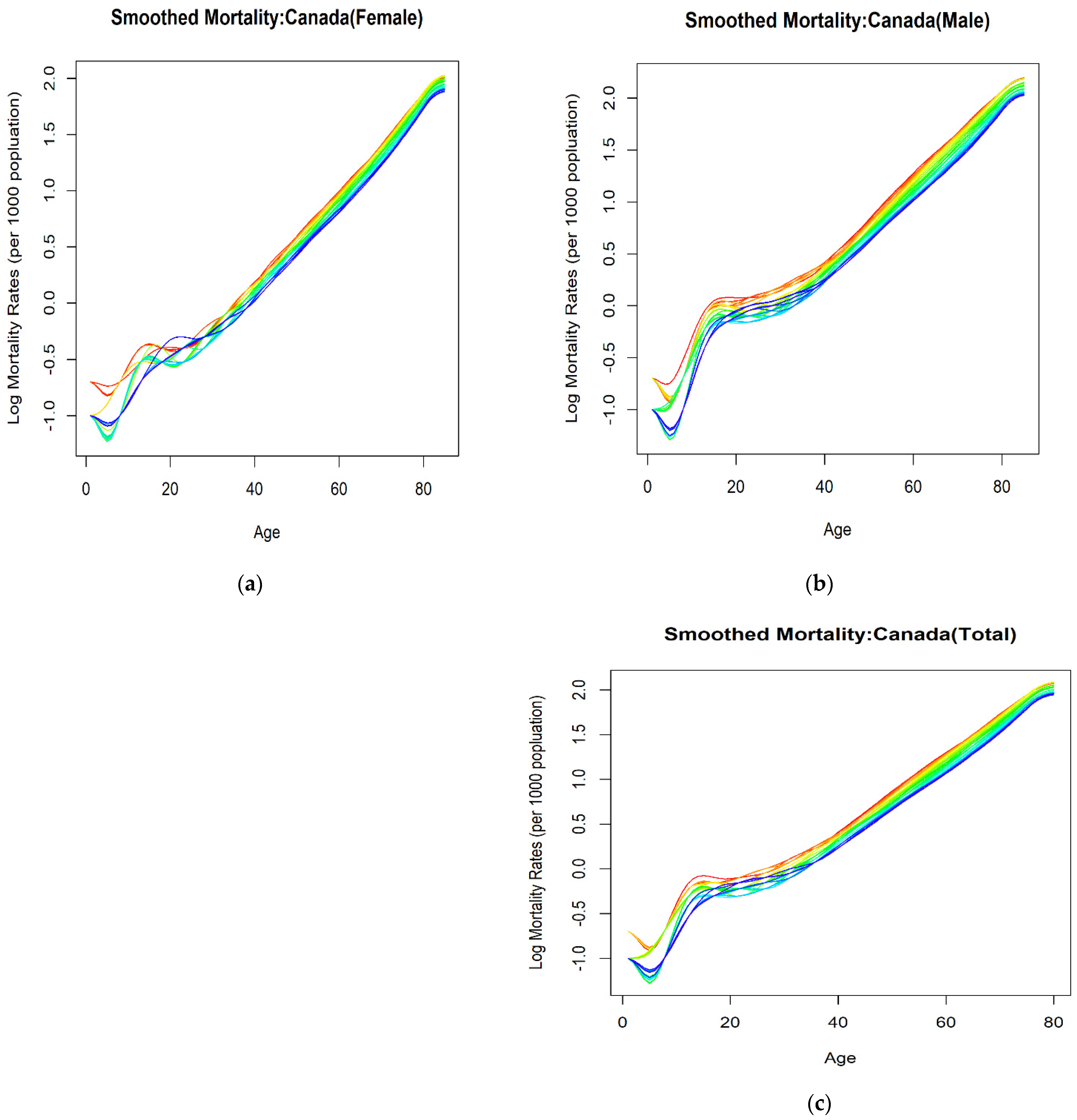
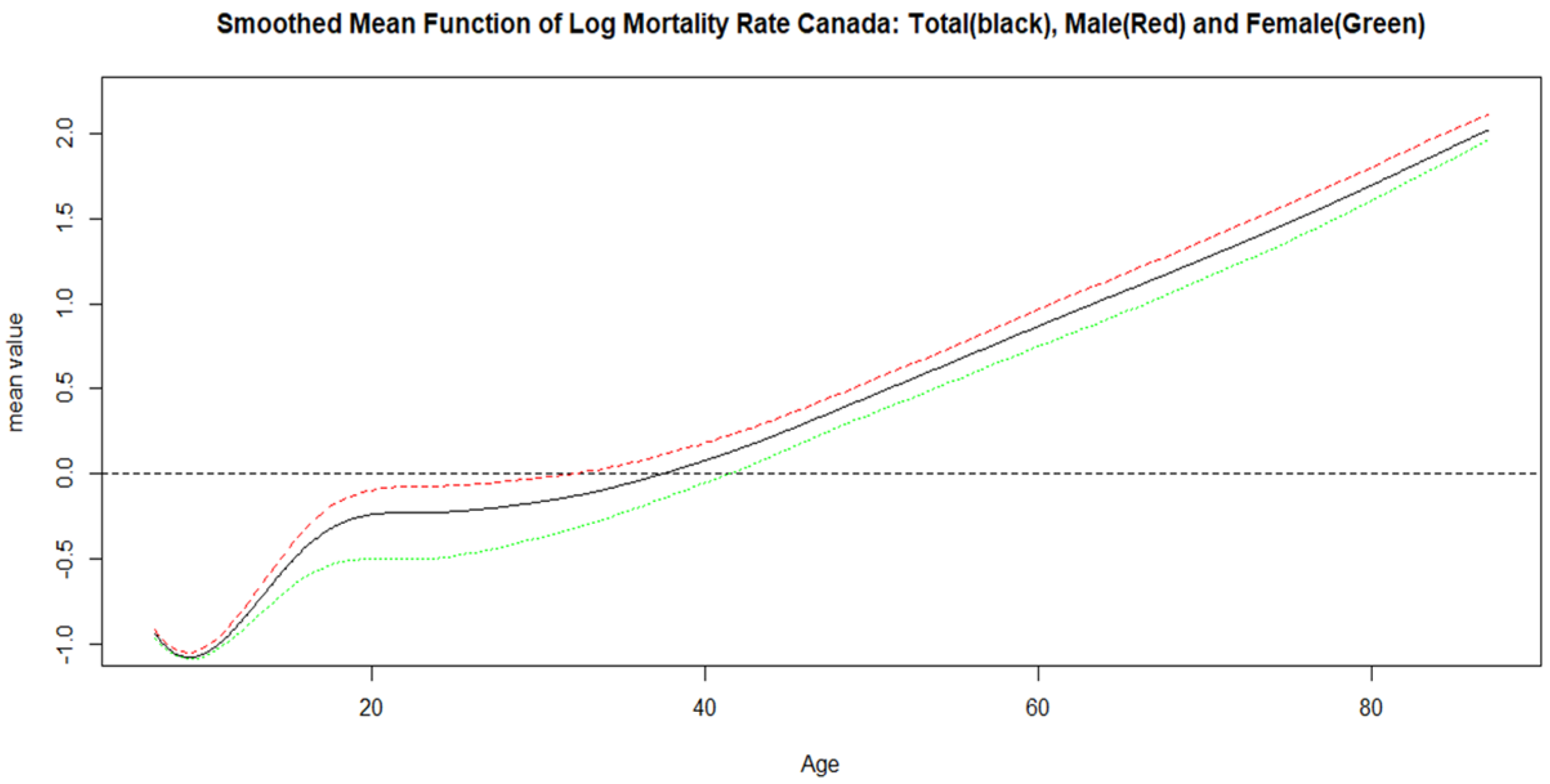


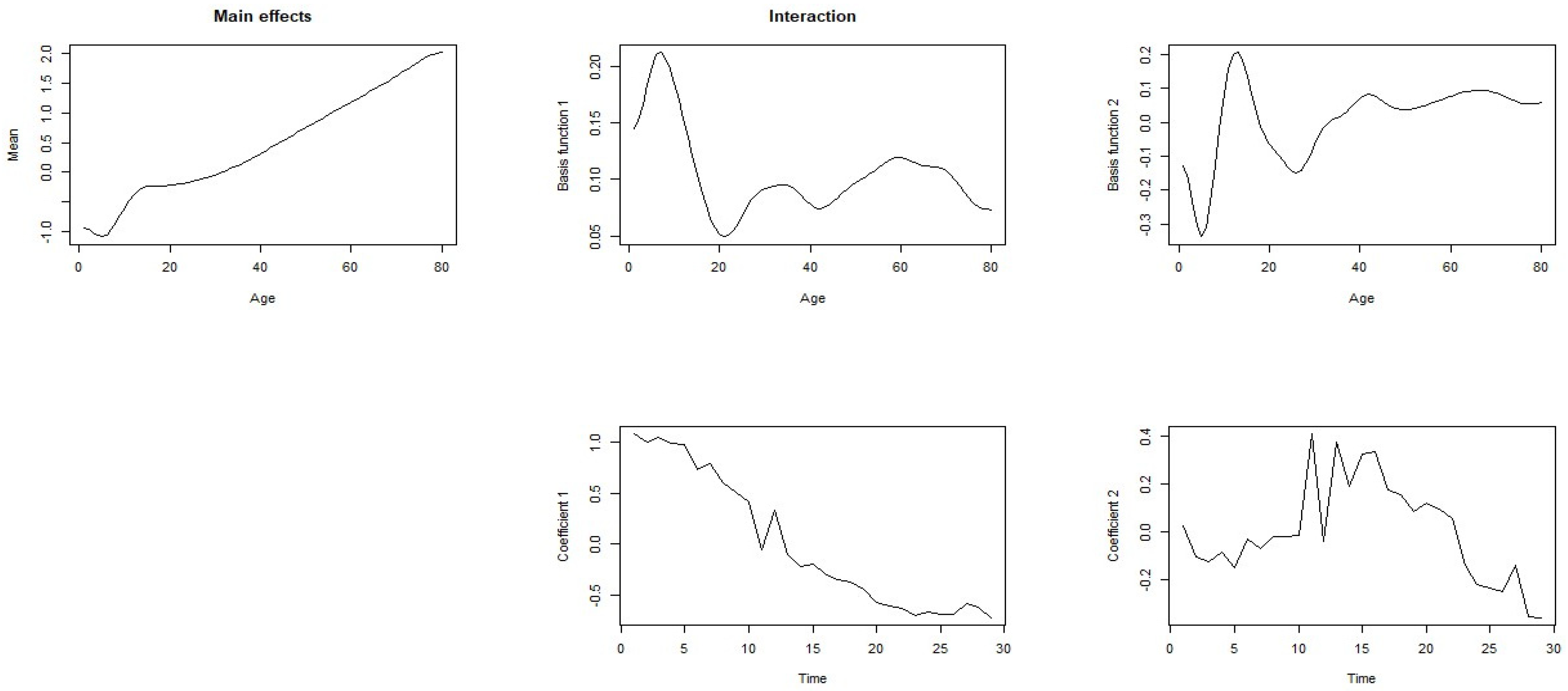

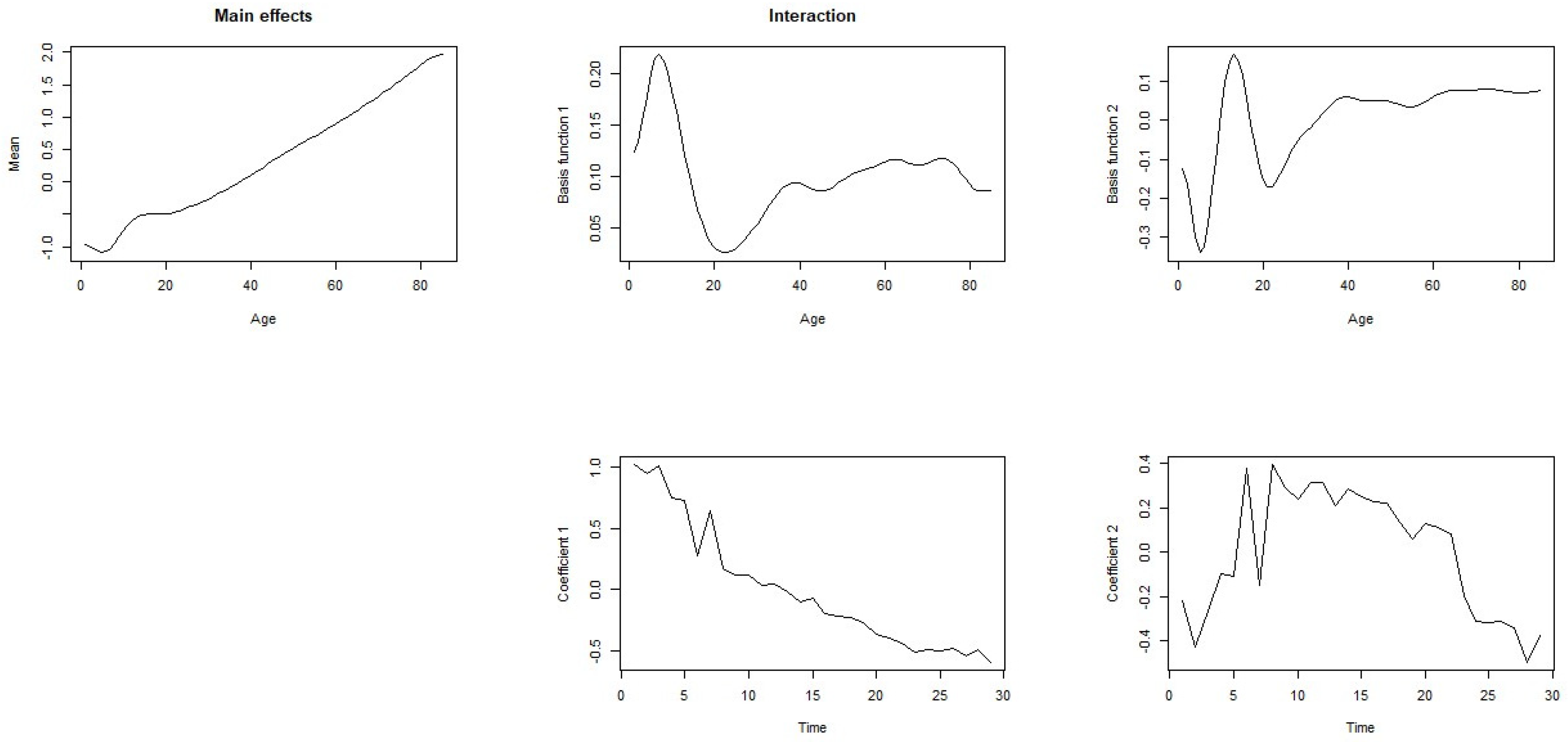
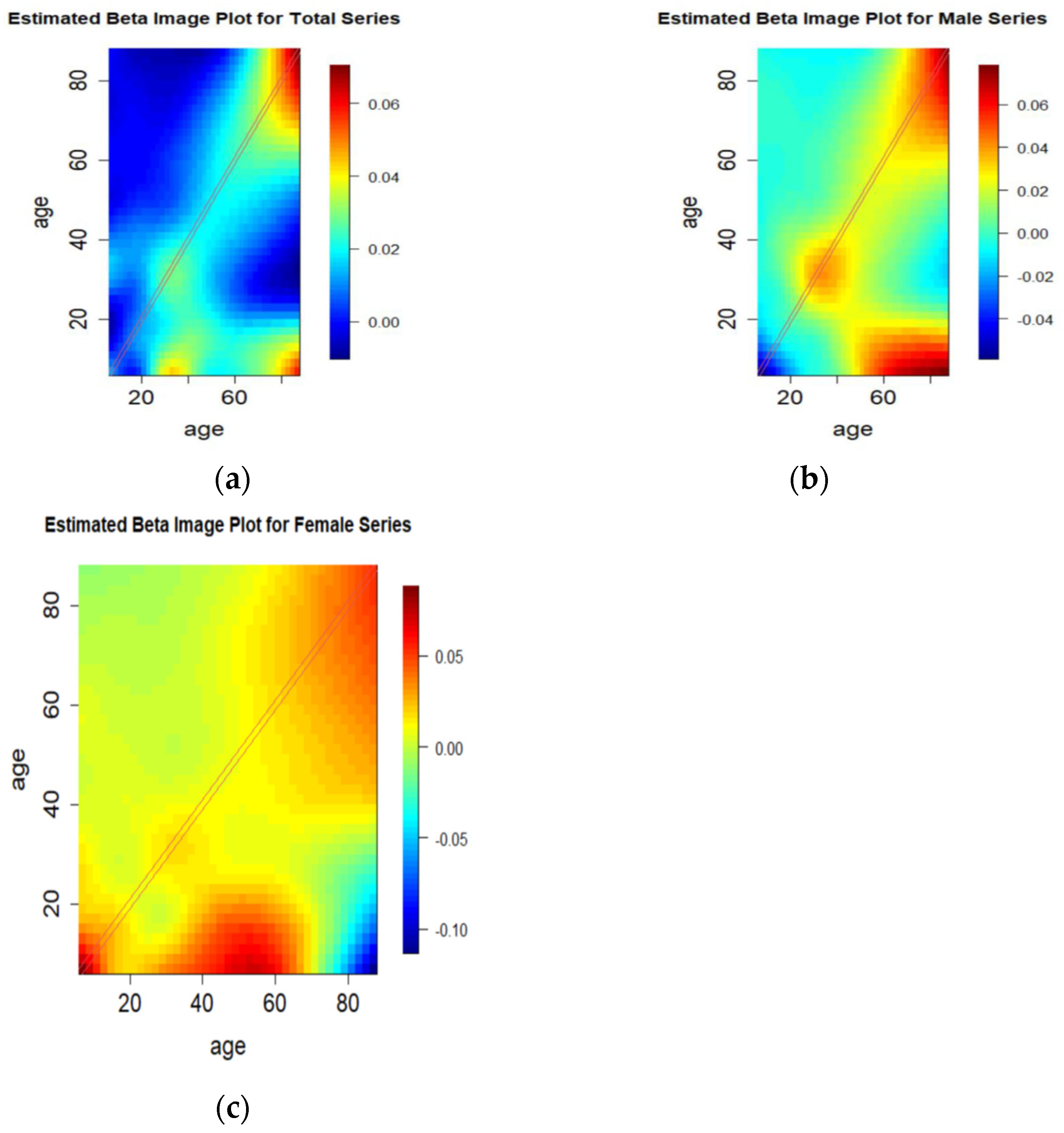
Disclaimer/Publisher’s Note: The statements, opinions and data contained in all publications are solely those of the individual author(s) and contributor(s) and not of MDPI and/or the editor(s). MDPI and/or the editor(s) disclaim responsibility for any injury to people or property resulting from any ideas, methods, instructions or products referred to in the content. |
© 2023 by the authors. Licensee MDPI, Basel, Switzerland. This article is an open access article distributed under the terms and conditions of the Creative Commons Attribution (CC BY) license (https://creativecommons.org/licenses/by/4.0/).
Share and Cite
Rahman, A.; Jiang, D. Forecasting Canadian Age-Specific Mortality Rates: Application of Functional Time Series Analysis. Mathematics 2023, 11, 3808. https://doi.org/10.3390/math11183808
Rahman A, Jiang D. Forecasting Canadian Age-Specific Mortality Rates: Application of Functional Time Series Analysis. Mathematics. 2023; 11(18):3808. https://doi.org/10.3390/math11183808
Chicago/Turabian StyleRahman, Azizur, and Depeng Jiang. 2023. "Forecasting Canadian Age-Specific Mortality Rates: Application of Functional Time Series Analysis" Mathematics 11, no. 18: 3808. https://doi.org/10.3390/math11183808




